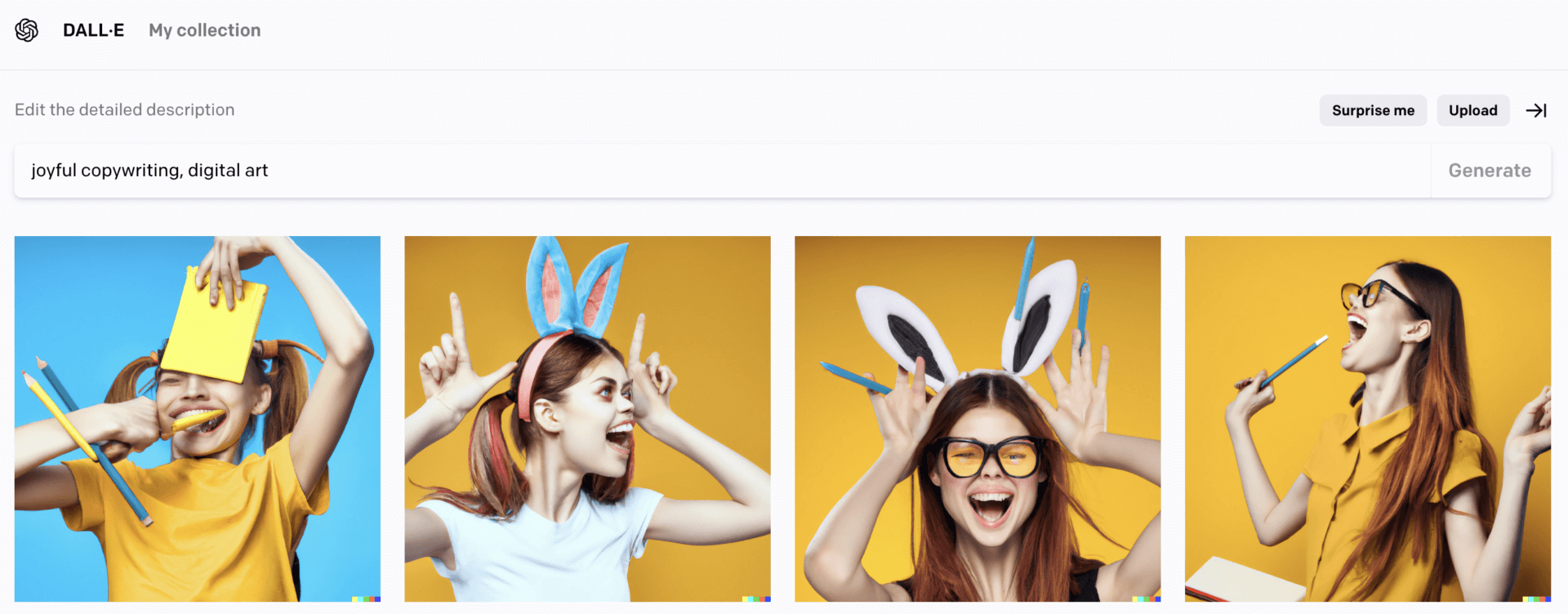Dall-E, AI copywriters, and the future of content creation
December 10, 2021
|
John Thomas
Dive into the world of AI in content creation and explore the impact of technologies like Dall-E. Learn how AI is shaping the future of content creation and its potential implications.

Broadcast news anchors, alarmists, and internet trolls love to catastrophize that one industry or another is on the verge of death thanks to technological advancements. However, their suspicions rarely come true.
For example, Uber and Lyft were supposed to kill the taxi industry. But New Yorkers can confirm that the unsightly yellow cabs are still rampant and can be cost-effective compared to ride-share apps.
Content creation is among the latest to fear a mass replacement. From AI-powered, text-to-image platforms like Dall∙E, to AI copywriting programs, and now text-to-video AI within Tiktok and Meta, content creators can’t help but wonder where the industry’s going and if their jobs will go with it.
A brief history of content creation
Content marketing has been around since at least the 1800s, although arguably since the earliest forms of human communication. There have always been storytellers using words to persuade people to take all kinds of action.
From a modern standpoint, many consider John Deere’s “The Furrow” magazine to be the first instance of content marketing. The Furrow focused on farming challenges and solutions, as well as advancements in farming technology, ultimately driving revenue and loyalty for John Deere.
Since then, we’ve seen:
In-flight airline magazines and multi-media content driving loyalty
Michelin’s well-known tourism guide encouraging travelers to put more miles on their tires
Comic books driving additional sales of costumes, toys, and movies
Blogs and websites lined with content that helps them rank on third-party search engines
Social media accounts that power brand awareness through entertainment and education
And most recently, experiential VR content that creates memorable brand connections
No matter the format, content marketing has a rich history of using technology to attract, convert, and retain audiences in a multitude of ways.
The marketing industry’s agility, creativity, and adaptability have created a demand for content writers, copywriters, illustrators, graphic designers, cartoonists, videographers, editors, and a series of support, technology, and operations roles that keep content workflows running smoothly. But as technological advancements get better at mimicking human-made content, many wonder what the future holds for content creators.
Related Content: The Content Marketing Playbook
Content creation in 2022
Today, technology is a marketers best friend. Project management software like Asana helps reduce the time it takes to get approvals and create content. Spelling and grammar aides like Grammarly ensure quality output. Design platforms like Canva and Figma make it easier to create and publish visually compelling content—we won’t even get started on Adobe’s suite.
But project management software hasn’t eliminated the Project Manager role, and Grammarly hasn’t replaced editors. So what is it about AI-powered image generators and AI copywriters that have shaken content creators?
How AI works
GPT-3, specifically, is a massive language model that takes an input (such as a sequence of words) and generates an output (such as another sequence of words). When accessed via an (invite-only) API, this model can be used to power a variety of programs and use cases.
Some examples of GPT-3 applications include:
Turning a description of a web app into a functioning website
Turning a keyword or phrase into an idea for a blog, like Draft’s article idea generator
Replying to a complex chatbot prompt automatically
AI and copywriting
We tried out several AI copy generators and the truth is they create quick, reasonable first drafts. But they also folded in assumptions and failed to create something that stands out.
For example, when requesting a product description for “chicken burger,” the AI took liberty and described the burger as “100% white meat” and “on a sesame seed bun.” While those certainly sound right, they weren’t details we provided in the brief, and were likely pulled from the 175 billion parameters that trained GPT-3.
Since this technology is based on tons of pre-existing, often human-written samples, many folks complain about AI’s repetition in copywriting. Similarly, you can’t expect an AI that’s trained on previously created work to write something that breaks that mold, a common brand marketing goal.
When you also consider the speed that language evolves today, accelerated by the internet, it’s easy to see how an AI might not be equipped to write for social media and other web placements. Humans who consume social media and understand the nuance of internet shorthand (like double entendres) are better equipped to sort through that chaos and provide real meaning to written work.
AI and image creation
Dall∙E 2 is a text-to-image AI that turns a few words or phrases into an image. It can edit existing images and generate new images based on its training.
If you’ve seen the memes, it’s easy to understand why folks are impressed with the technology. In fact, the social media virality of Dall∙E Mini prompted Tiktok to create its own, simple, in-app, text-to-image AI.
However, trained, professional designers and illustrators rarely get such a simple or straightforward brief as “a corgi playing a flame throwing trumpet.”

Image source: Assembly AI
The reality of graphic design, illustration, and photography—especially in a professional setting—is that it solves a deeper problem. For example, a magazine or newspaper might hire a designer to help them display complex pieces of data in an easy-to-understand format that incorporates brand colors and speaks to a specific demographic and psychographic audience.
You can probably imagine the inherent complexity of this. And Dall∙E 2 repeatedly fails that practicality test. Even simpler prompts like “joyful copywriting” turn up some frightening results.

Even if you ignore the creepy AI faces and illegible text, anyone can see Dall∙E’s limitations in applied design. Don’t ditch your designers, photographers, or even your stock photo platforms any time soon.
AI and video creation
Similar to text-to-image AI, text-to-video AI models let users type in a text description of a video clip or scene (or upload an image), and it generates a video matching the prompt. For Meta’s Make A Video tool specifically, the clips are limited to 5 seconds and don’t offer audio. Also similar to text-to-image AI, these videos are disappointingly artificial and wrought with distortions, blurs, and other flaws.
Ultimately, while these tools may be fun for individuals to play with, they won’t replace brand videographers any time soon. That said, text-to-video represents a stark advancement in AI content generation.
An optimist’s future for AI-powered content creation
The fear of being replaced by AI doesn’t live up to the reality of its capabilities today. Similar to concerns about whether writers would be replaced by algorithms when those were the latest buzzy technology, these fears will seem silly in hindsight.
Heck, we live (and work) alongside algorithms every day now. In fact, new generations are so aware of the omnipresence of algorithms that they customize algorithmic outputs, such as their For You pages on Tiktok.
That said, AI definitely has a place on the content team of the future. As AI gets faster and more sophisticated, expect to see AI tools make their way into content creators’ hands as a productivity aide.
For example, rather than starting from scratch, a copywriter in 2025 might start with an AI-first draft. From there the human writer can do more of the research, brand alignment, tactical keyword placement, emotional evocation, and other strategic writing practices that take a piece from good to great.
Another example might have a graphic designer start with several variations of output from an AI that help bring together concepts where creative swipe files and mock-ups are required today. From there, the human pro can create something truly bespoke, on brand, and high quality for their client.
With this informed starting point, the content creator of the future might create twice as much work in the same amount of time, overcoming creative blocks as they go. The key is making AI a part of the team rather than the only player.



